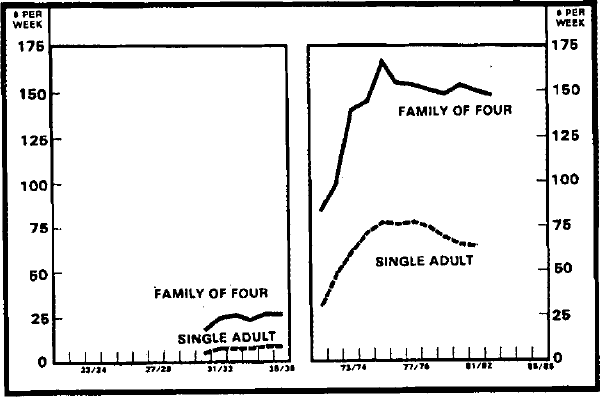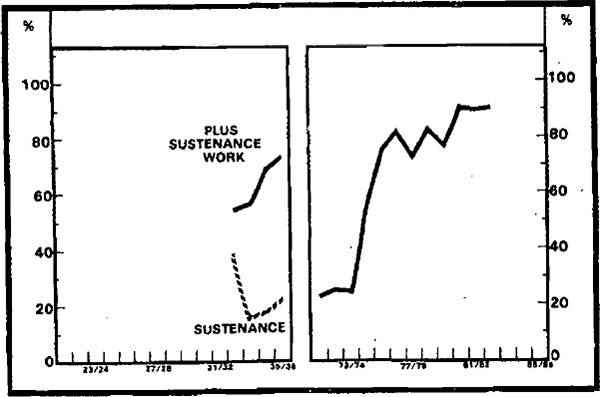RDP 8303: The 1930's and the 1980's: Some Facts Attachment 2: Unemployment Benefits in 1930's and 1980's
September 1983
- Download the Paper 1.57MB
This attachment compares the amount of official assistance received by the unemployed in the 1930's and In the 1980's.
Information on unofficial assistance is sparse but such assistance was almost certainly relatively larger in the 1930's.
The unemployed received three kinds of official assistance during the Great Depression:
- Assistance (variously known as “sustenance”, “food relief” or “rations”) which was given to the unemployed who were not participating in relief work programs;
- Sustenance work. Wages much below award wages were paid on the condition that the assisted work one or two days a week in special “make-work” schemes;
- Miscellaneous assistance, in particular with regard to health, housing and retraining.
Today unemployment benefits are paid in cash rather than partly in kind and various forms of miscellaneous assistance have been expanded considerably.
I. SUSTENANCE AND SUSTENANCE WORK
The rapid rise in unemployment in the early 1930's overwhelmed traditional methods of relieving unemployment. Sustenance programs were set up in the latter months of 1930. Excepting Queensland, most States avoided sustenance work schemes until late 1933 when they were expanded rapidly. Graph 1 shows the expansion in sustenance and sustenance work relief in the early 1930's. By June 1934 the ratio of sustenance workers to ordinary sustenance recipients was around 2.6 in New South Wales and 3.6 in Victoria.
UNEMPLOYMENT AND UNEMPLOYMENT RELIEF

Graph 2 shows the value of the rate of sustenance in N.S.W. in the 1930's expressed at 1982 prices and compares it to the current rate of unemployment benefits. Since the early 1930's, prices have risen about 15 times, while the benefit for a family has increased about 90 times. Clearly, the purchasing power of benefits has vastly increased.
| Sustenance | Sustenance[1] | Unemployment Benefit June 1982 $ |
|||
|---|---|---|---|---|---|
| Sept. 1933 | |||||
| sd, 1933 prices | $, 1982 prices | s d, 1933 prices | $, 1982 prices | ||
| 16–17 year old | 5/6 | 7.95 | 9/5 | 13.61 | 36.00 |
| Single Adult | 5/6 | 7.95 | 9/5 | 13.61 | 58.10 |
| Married & Two Children |
16/6 | 23.86 | 21/10 | 31.56 | 143.60 |
UNEMPLOYMENT BENEFITS

The comparison probably underestimates the increase in benefits between the two periods since in most States in the 1930's sustenance was in the form of food rations, and elementary welfare economics suggest that the welfare gain of a cash benefit exceeds that of a benefit-in-kind of equal money value. Confirming this, some of the unemployed were quoted by unemployment relief authorities in the 1930s as saying 10/- of cash was worth 20/- of food rations.[2]
But how many were eligible for assistance? With regard to age, eligibility conditions were relatively liberal. In both N.S.W. and Victoria 16 and 17 year olds could receive the single adult benefit.[3] Other conditions were more difficult to meet. In the otherwise generous Queensland Unemployment Insurance Scheme assistance was limited to 13 weeks in any one year. In New South Wales in 1932 the recipient with a family of four must have exhausted any realisable wealth (apart from his house) and have income of less than 25/- a week, about $35 in today's prices. Today, there is no assets test for unemployment benefit, though the income test remains. A married person with two children will receive no benefit if his income exceeds $192.30 per week.
Either the sum of eligibility conditions were difficult to meet, or there was an aversion to “going on the dole”, since the proportion of unemployed receiving relief in the Depression is surprisingly small. Graph 3 shows the ratio of sustenance and sustenance work recipients to unemployed in New South Wales in the mid 1930's and compares that to the ratio of beneficiaries to unemployed in New South Wales in recent years. It shows that in New South Wales in 1933, when unemployment was around 25 per cent, only a slight majority of the unemployed received either sustenance or sustenance work.[4]
So about 12 per cent of the workforce was unemployed but received no assistance from the government. (Graph 3 shows the ratio rising considerably in the mid-30s because unemployment was falling rapidly but the sustenance-work schemes were maintained.)
N.S.W. UNEMPLOYMENT BENEFICIARIES

III. MISCELLANEOUS ASSISTANCE
Health
The provision of almost free health care is an important form of assistance to the unemployed today. The Health Care card entitles its holder to free public hospital care and pays 85–100 per cent of medical services. In June 1982 about 85 per cent of unemployed held Cards. The unemployed are also entitled to pharmaceutical prescriptions at 50 per cent of the cost charged to the general public. In contrast, there was little organised assistance for health care in the Great Depression, though some charitable hospitals would have helped. In Queensland single unemployed men were entitled to free medical care. In New South Wales organised medical care for the unemployed only began in 1937.
Housing
The “Rent Problem” was a vexatious issue of the 1930's. Most States only supplied food rations to the unemployed and so there was no cash to pay the rent. Even in States where cash was granted the cost of housing was much larger.[5] This situation led to the “Happy Valleys” of the Great Depression.
To alleviate the situation the Lang Government legislated to allow tenants to secure Court orders indefinitely postponing eviction. There was also some financial assistance (£70,000 in New South Wales in 1932/3) and the Unemployed Housing Fund provided shelter for some. Victoria supplied accommodation at 8/- a week to evicted tenants. Government camps supplied accommodation to men in Western Australia and Queensland. In Queensland workers in the Intermittent Relief Scheme who were evicted from private accommodation were entitled to a hut valued at £10.
Today, despite the vast increase in unemployment benefits, there is still a rent problem. People who are unemployed because they are sick are eligible for $10 a week rent assistance (this program cost $5 million in 1981/82). ft much broader program of rent relief was instituted in January 1983. This program provides “one-off” grants to the unemployed for bonds and rent-in-advance. In the period January–June 1983 about 19,000 families in New South Wales were granted $5.2 million (This was the equivalent of an average payment of about $10 per family per week).
Retraining
In New South Wales in the early 1930's about 1,000 unemployed teenagers were given 12 months' free instruction at Technical Colleges and Trades Schools each year.[7] Another 500 were trained in “rural pursuits” each year. By 1938/39 £200,000 per annum was spent on retraining, about $5.0 million at today's prices.[8]
Retraining for the unemployed is available in a much greater variety and depth today. In the 1982/3 Commonwealth Budget $93.4 million were allocated for the Education Programme for Unemployed Youth, Special Youth Employment Training Programme and General Training Assistance for the Unemployed. 116,150 people were expected to be trained by these programmes in 1982/3.[9]
Footnotes
1931 Labour Report (Feb. 1933), Commonwealth Bureau of Census and Statistics P. 109. This has been converted into 1982 prices using a retail price index going back to 1901 published in 1981 Australian Year Book. [1]
Annual Report of N.S.W. Unemployment Relief Council, 1933/34 P.22. [2]
F.A. Bland “Unemployment Relief in Australia”, International Labour Review July 1934 pp 34, 38. In Queensland until July 1932 single men 18 and over were required to travel across the State to look for work in order to receive their “travelling rations” of 5/- a week. [3]
| Sustenance Recipients | Sustenance Work Recipients June 1933 |
Total Recipients | Unemployed | Ratio | |
|---|---|---|---|---|---|
| N.S.W. | 83,151 | 34,229 | 117,380 | 222,506 | 53% |
| VIC. | 8,525 | 18,943 | 27,468 | 119,791 | 23% |
The data for sustenance recipients come from the Year Books of N.S.W. and Victoria. The data for unemployed comes from the 1933 census.
The unemployment figures used for the calculation of the ratio used in the graph for the 1930's comes from a series in the 1937/38 N.S.W. Yearbook. It is not a primary series but an estimate.
[4]Labour Report (Feb. 1933), Commonwealth Bureau of Census and Statistics p 142. The average rental for a house of four or five bedrooms in 1932 was 17/7, larger than the money value of sustenance in many States. In June 1983 in Sydney the median rental for a 3 bedroom house was $116.20[6] a week, compared to unemployment benefits of $157.30 for a family of four. The figures quoted have suggested that rents have over risen 60 times since the Depression (while the CPI has risen about 15 times). [5]
Annual Review of the Rental Property Market 1982/83 The Real Estate Institute of Australia. [6]
1933/34 Annual Report of Unemployment Relief Council of New South Wales P.13. [7]
1938/39 N.S.W. Yearbook P.964. [8]
Statement No. 3 1982/83 Budget pp 187–192. [9]